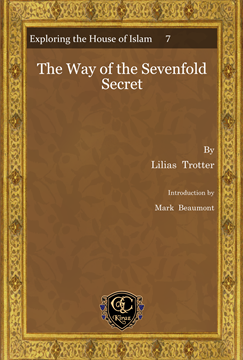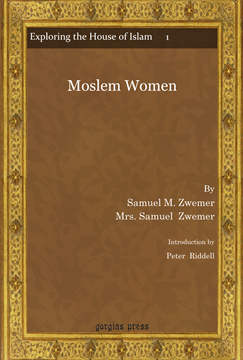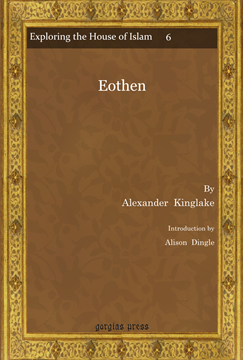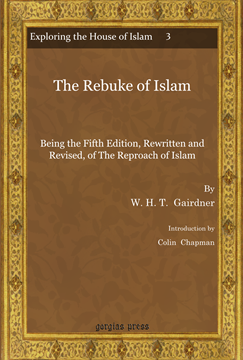Exploring the House of Islam: Perceptions of Islam in the Period of Western Ascendancy 1800-1945
This is a series of re-publications of writings by Europeans, Americans and other non-Muslims on Islam from the nineteenth and twentieth centuries up to the end of the Second World War. This period of Western political, economic, cultural and religious impact on the Islamic world is shown through the eyes of mainly European and American Scholars, Travellers, Missionaries and others who perceived Muslim culture in a variety of ways. The series is devoted to three kinds of perception: of Islamic History and Institutions; of Islamic Religion and Culture; and of Islam in comparison with Christianity. Making these works available again will enable renewed understanding of the attitudes and actions of non-Muslims in their engagement with Islam.
The Way of the Sevenfold Secret
By Lilias Trotter; Introduction by Mark Beaumont
Series: Exploring the House of Islam: Perceptions of Islam in the Period of Western Ascendancy 1800-1945 7
ISBN: 978-1-61719-942-4
Lilias Trotter moved from England to Algiers in 1888, at the age of 35, and died there in 1928. In the latter stages of her mission there, she wrote specifically for Muslims influenced by mysticism. Lilias based The Way of the Sevenfold Secret on Christ’s seven ‘I am’ sayings in John’s gospel, and attempted to link them to the traditional seven steps taken by members of Sufi orders in their quest for union with God. This republication should enable readers to capture the essence of a woman whose legacy is vitally alive for our times.
$165.00 (USD)
Moslem Women
Series: Exploring the House of Islam: Perceptions of Islam in the Period of Western Ascendancy 1800-1945 1
ISBN: 978-1-60724-409-7
Moslem Women is built around six main chapters; half are devoted to the place and experiences of Moslem women, and half consider the Christian mission to these women. The Zwemers acknowledge some of the great women of Islamic history, such as Rabia, the famous early mystic, and Nurah Mahal, wife of the Mughal Emperor Jahangir. They speak in glowing terms about advances in the women’s situation in post-Ottoman Turkey. Their work is dedicated to serving Muslims and to seeing them as people rather than as faceless numbers; it is an excellent model for today’s Christians who feel called to engagement with Islam.
$189.00 (USD)
Eothen
By Alexander Kinglake; Introduction by Alison Dingle
Series: Exploring the House of Islam: Perceptions of Islam in the Period of Western Ascendancy 1800-1945 6
ISBN: 978-1-60724-664-0
Given the twenty-first century association between the Holy Land and the Bible, we may assume that such a relationship just exists, and that the land is like the Book and contains a timeless quality. Eothen requires us to question this supposition. Alexander Kinglake describes a Palestine which is largely a wilderness on the verge of being defined by the political and religious forces of the west. He offers us a glimpse into the past of a society as it begins to engage with the West.
$148.00 (USD)
Its Saints and Shrines
An Introduction to the Study of Sufism with Special Reference to India
By John A. Subhan; Introduction by David Singh
Series: Exploring the House of Islam: Perceptions of Islam in the Period of Western Ascendancy 1800-1945 5
ISBN: 978-1-60724-413-4
A convert to Christianity from the Qadiri Order, John A. Subhan is well-known for his seminal work, Sufism: Its Saints and Shrines. Sufism prepared him for faith in Jesus and his Injil. His Sufi background and intimate knowledge of its beliefs and practices enabled him to explain Sufism to others. All ten chapters in Sufism are interesting, including chapter eight, which contains a comparative discussion of Sufism in the broader Hindu context. It is a must read for all, not only because it is a window into the world of a great Sufi convert but also because his insight is still relevant today.
$193.00 (USD)
Christianity and Islam
The Bible and the Koran
By W. R. W. Stephens; Introduction by Clinton Bennett
Series: Exploring the House of Islam: Perceptions of Islam in the Period of Western Ascendancy 1800-1945 4
ISBN: 978-1-60724-412-7
Based on lectures delivered in Chichester Cathedral, this book mirrors typical nineteenth century English attitudes toward the non-European space. This needed Christianity and European political oversight, or its people would remain backward and spiritually lost. The book shows how someone whose inclinations were liberal could look at Islam and dislike what he saw. On the other hand, the book also shows that a non-specialist scholar in the second half of the nineteenth century could write seriously if not impartially about Islam using material available in European languages. This suggests that Islam was a subject of increasing interest in Victorian England.
$133.00 (USD)
The Rebuke of Islam
Being the Fifth Edition, Rewritten and Revised, of The Reproach of Islam
By W. H. T. Gairdner; Introduction by Colin Chapman
Series: Exploring the House of Islam: Perceptions of Islam in the Period of Western Ascendancy 1800-1945 3
ISBN: 978-1-60724-411-0
Temple Gairdner’s The Rebuke of Islam, published in 1920, has long been recognized as one of the classics of Christian response to Islam in the early 20th century. Part of its significance is that Gairdner’s approach sums up the very best of earlier approaches (especially in the 19th century), but breaks significantly new ground and therefore points forward to approaches that have been developing between his time and the present day.
$154.00 (USD)
Mohammed and Islam
By Ignaz Goldziher; Translated by Kate Seelye; Introduction to the 1917 edition by Morris Jastrow; Introduction to the 2009 edition by Douglas Pratt
Series: Exploring the House of Islam: Perceptions of Islam in the Period of Western Ascendancy 1800-1945 2
ISBN: 978-1-60724-410-3
Ignaz Goldziher was a pre-eminent scholar of Islam during the late 19th and early 20th centuries. This book encapsulates his own lifetime of work and provides something of an historical commentary on his epoch in the Western academic study of Islam. One of its strengths is that Goldziher’s investigation of historical development probes into underlying religious motivations and allied theological issues. The book quickly became a classic of its day. It remains a classic that, in our day, is well worth re-visiting as it can still inform our understanding of contemporary Islam, whose roots lie in all that Goldziher covers.
$180.00 (USD)







